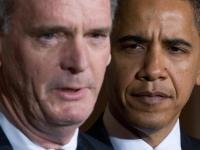BOB GARFIELD: This week, President Obama signed the 787-billion-dollar stimulus package into law. The bill received no Republican votes in the House and only three in the Senate. And for a president who said he wanted more bipartisanship in Washington, eh, not a great story.
[CLIPS]:
[MUSIC UP AND UNDER]
MALE CORRESPONDENT: Wow, a funny thing happened on the way to the honeymoon. Republicans scowled and growled and asked, where’s the bipartisanship?
[OVERTALK]
MALE CORRESPONDENT: - The president’s harshly partisan as anything I saw – well, my gosh, it’s the same with George Bush. I'm going to be –
[SOUND TRAILS OFF]
FEMALE CORRESPONDENT: President Obama has to realize that this really lofty goal of bipartisanship isn't necessarily achievable.
MALE CORRESPONDENT: Two-hundred-and-nineteen possible Republican votes. Obama got three. How could he possibly say there’s bipartisanship?
[END OF CLIPS]
BOB GARFIELD: But what does the word “bipartisan” really mean? James Morone is the chair of the Political Science Department at Brown University. He joins us. Jim, welcome to the show.
JAMES MORONE: Bob, hi. I'm glad to be on.
BOB GARFIELD: Is it your sense that in their take on what constitutes bipartisanship the media was looking for some kind of ebony and ivory hand-in-hand ideal of collegiality on Capitol Hill?
JAMES MORONE: The great Kumbaya moment. Part of this is just that great old American myth that once upon a time we lived in a land where every side got together, particularly in hard times, and we've lapsed from that time. And that really is a myth. Go back to the New Deal, a worse economic crisis than this one, obviously, and for a time the Republicans really did pitch in and help Franklin Roosevelt out. Flash forward just two years. We're still in the Great Depression, and Social Security comes before Congress. One lone Republican from New Jersey voted for Social Security, everybody else against it. So we shouldn't get into this idea that there was once a rosy past where we all got along during hard times, because American history just doesn't bear that out.
BOB GARFIELD: Well, let's go a little farther back to the late 19th century. Tell me about the Mugwumps.
JAMES MORONE: The Mugwumps were a group of gentlemen called Mugwumps because they straddled the political fence. Their mugs faced one way and their wumps faced another. The Mugwumps believed that there was way too much politics in politics. The Mugwumps used to love to say, there’s no Republican or Democratic way to pave a street. The old party stalwarts treated the Mugwumps with great contempt. The pejorative that stuck was “goo-goo,” short for goody-goody, and it stuck because this goo-goo illusion is the illusion that all politics can be boiled down to efficient public service. It’s not about efficiency. It’s about choosing between clashing values. Do you want more government? Do you want less? Politics is how we sort out, how we fight, how we battle, how we choose between clashing views of the world.
BOB GARFIELD: So are the media naive in speaking about this Platonic ideal of bipartisanship as if it were something that’s actually achievable?
JAMES MORONE: There’s never been an era that you can point to and say, ah, a bipartisan era. But there have been great pan moments. One example that comes to mind is the civil rights legislation of 1964 and 1965. There’s a case where the Democrats could not pass that legislation, divided by Southern Democrats and Northern – a 67-day filibuster. And the day was saved by a small group of Republicans, led by Everett Dirksen of Illinois, who came to the rescue and, really quite bravely, broke the filibuster and helped pass the civil rights legislation – a great bipartisan moment, though Lyndon Johnson says, as he signs it, there goes the South for the Democrats. And sure enough, there it went. The real problem, Bob, I think, of what’s been going on in the media over the Obama effort at bipartisanship is the media has really focused on things they can count. So count the number of Republican votes. Zero. That’s a failure. It’s not bipartisan. There’s another thing you can count – the poll numbers. Republicans, looking bad - Obama, looking good. So his effort at bipartisanship has been a success from that perspective. It’s much harder to get a handle around the tone of the conversation in Washington. And in that sense, Obama’s been trying to do something new that the media has completely let slide under their radar screen, that is, change the tone, if not necessarily the outcomes, of the conversation.
BOB GARFIELD: Jim, thank you very much.
JAMES MORONE: It was a lot of fun.
BOB GARFIELD: James Morone is the chair of the Department of Political Science at Brown University and author of the upcoming book, The Heart of Power: Health and Politics in the Oval Office.
